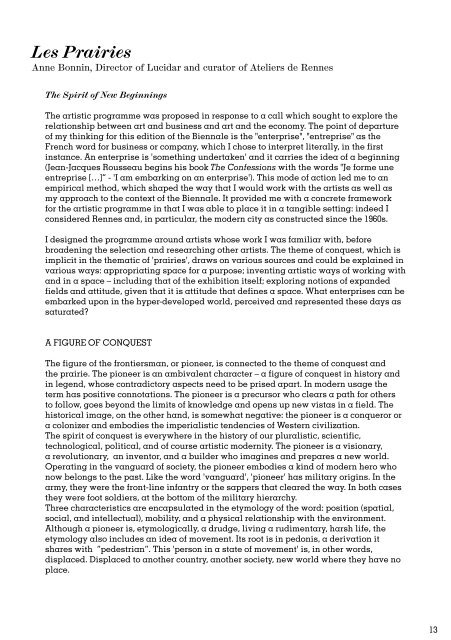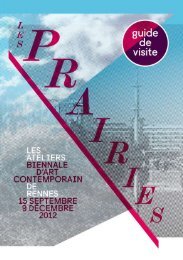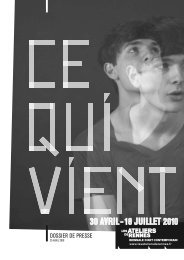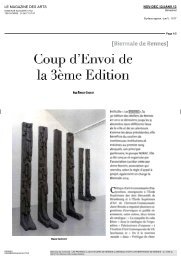Download here the Visitor's guide. - Les Ateliers de Rennes
Download here the Visitor's guide. - Les Ateliers de Rennes
Download here the Visitor's guide. - Les Ateliers de Rennes
You also want an ePaper? Increase the reach of your titles
YUMPU automatically turns print PDFs into web optimized ePapers that Google loves.
<strong>Les</strong> Prairies<br />
Anne Bonnin, Director of Lucidar and curator of <strong>Ateliers</strong> <strong>de</strong> <strong>Rennes</strong><br />
The Spirit of New Beginnings<br />
The artistic programme was proposed in response to a call which sought to explore <strong>the</strong><br />
relationship between art and business and art and <strong>the</strong> economy. The point of <strong>de</strong>parture<br />
of my thinking for this edition of <strong>the</strong> Biennale is <strong>the</strong> "enterprise", "entreprise" as <strong>the</strong><br />
French word for business or company, which I chose to interpret literally, in <strong>the</strong> first<br />
instance. An enterprise is 'something un<strong>de</strong>rtaken' and it carries <strong>the</strong> i<strong>de</strong>a of a beginning<br />
(Jean-Jacques Rousseau begins his book The Confessions with <strong>the</strong> words "Je forme une<br />
entreprise […]” - 'I am embarking on an enterprise'). This mo<strong>de</strong> of action led me to an<br />
empirical method, which shaped <strong>the</strong> way that I would work with <strong>the</strong> artists as well as<br />
my approach to <strong>the</strong> context of <strong>the</strong> Biennale. It provi<strong>de</strong>d me with a concrete framework<br />
for <strong>the</strong> artistic programme in that I was able to place it in a tangible setting: in<strong>de</strong>ed I<br />
consi<strong>de</strong>red <strong>Rennes</strong> and, in particular, <strong>the</strong> mo<strong>de</strong>rn city as constructed since <strong>the</strong> 1960s.<br />
I <strong>de</strong>signed <strong>the</strong> programme around artists whose work I was familiar with, before<br />
broa<strong>de</strong>ning <strong>the</strong> selection and researching o<strong>the</strong>r artists. The <strong>the</strong>me of conquest, which is<br />
implicit in <strong>the</strong> <strong>the</strong>matic of 'prairies', draws on various sources and could be explained in<br />
various ways: appropriating space for a purpose; inventing artistic ways of working with<br />
and in a space – including that of <strong>the</strong> exhibition itself; exploring notions of expan<strong>de</strong>d<br />
fields and attitu<strong>de</strong>, given that it is attitu<strong>de</strong> that <strong>de</strong>fines a space. What enterprises can be<br />
embarked upon in <strong>the</strong> hyper-<strong>de</strong>veloped world, perceived and represented <strong>the</strong>se days as<br />
saturated?<br />
A FIGURE OF CONQUEST<br />
The figure of <strong>the</strong> frontiersman, or pioneer, is connected to <strong>the</strong> <strong>the</strong>me of conquest and<br />
<strong>the</strong> prairie. The pioneer is an ambivalent character – a figure of conquest in history and<br />
in legend, whose contradictory aspects need to be prised apart. In mo<strong>de</strong>rn usage <strong>the</strong><br />
term has positive connotations. The pioneer is a precursor who clears a path for o<strong>the</strong>rs<br />
to follow, goes beyond <strong>the</strong> limits of knowledge and opens up new vistas in a field. The<br />
historical image, on <strong>the</strong> o<strong>the</strong>r hand, is somewhat negative: <strong>the</strong> pioneer is a conqueror or<br />
a colonizer and embodies <strong>the</strong> imperialistic ten<strong>de</strong>ncies of Western civilization.<br />
The spirit of conquest is everyw<strong>here</strong> in <strong>the</strong> history of our pluralistic, scientific,<br />
technological, political, and of course artistic mo<strong>de</strong>rnity. The pioneer is a visionary,<br />
a revolutionary, an inventor, and a buil<strong>de</strong>r who imagines and prepares a new world.<br />
Operating in <strong>the</strong> vanguard of society, <strong>the</strong> pioneer embodies a kind of mo<strong>de</strong>rn hero who<br />
now belongs to <strong>the</strong> past. Like <strong>the</strong> word 'vanguard', 'pioneer' has military origins. In <strong>the</strong><br />
army, <strong>the</strong>y were <strong>the</strong> front-line infantry or <strong>the</strong> sappers that cleared <strong>the</strong> way. In both cases<br />
<strong>the</strong>y were foot soldiers, at <strong>the</strong> bottom of <strong>the</strong> military hierarchy.<br />
Three characteristics are encapsulated in <strong>the</strong> etymology of <strong>the</strong> word: position (spatial,<br />
social, and intellectual), mobility, and a physical relationship with <strong>the</strong> environment.<br />
Although a pioneer is, etymologically, a drudge, living a rudimentary, harsh life, <strong>the</strong><br />
etymology also inclu<strong>de</strong>s an i<strong>de</strong>a of movement. Its root is in pedonis, a <strong>de</strong>rivation it<br />
shares with “pe<strong>de</strong>strian”. This 'person in a state of movement' is, in o<strong>the</strong>r words,<br />
displaced. Displaced to ano<strong>the</strong>r country, ano<strong>the</strong>r society, new world w<strong>here</strong> <strong>the</strong>y have no<br />
place.<br />
13






